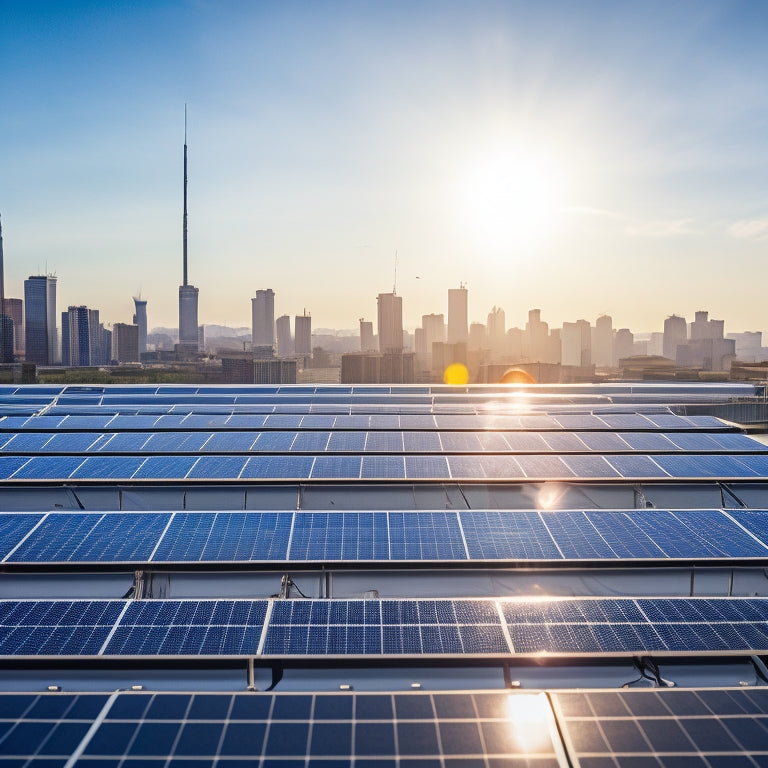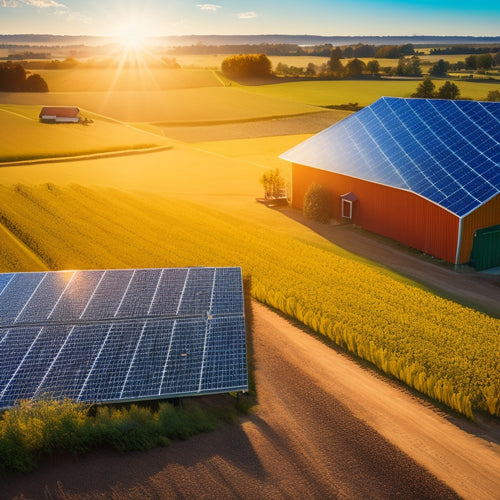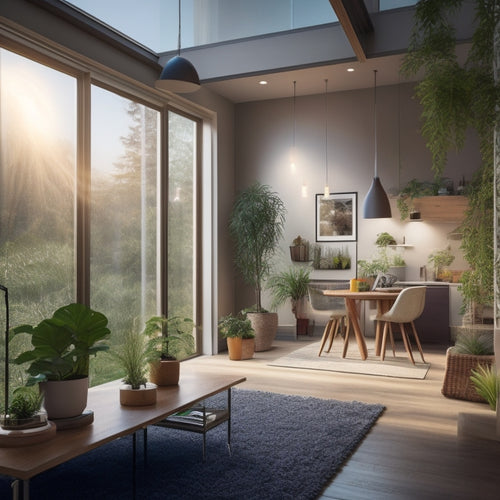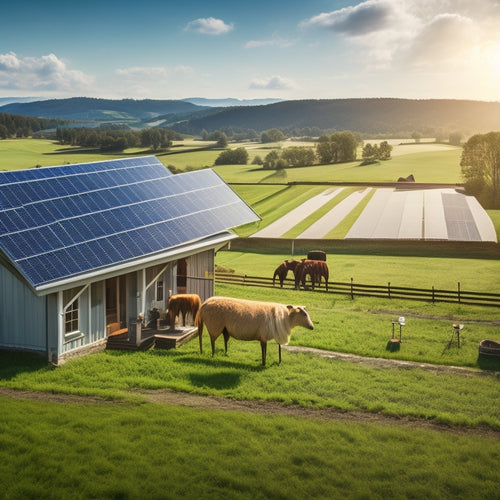
Why Proper Design Matters in Commercial Solar Systems
Share
Proper design in commercial solar systems guarantees maximum energy efficiency by correctly orienting and tilting panels, avoiding shadowing, and utilizing advanced tracking systems. It greatly lowers operational costs and reduces maintenance by optimizing energy capture and using high-quality components. You've got to make sure the system's durability by opting for corrosion-resistant materials and designing for local environmental conditions. Strict adherence to local codes guarantees reliability and safety. Proper design also includes a detailed site assessment and compliance for easier permit acquisition, as well as aesthetic and scalable integration. Understanding these aspects sets your solar installation up for success. Explore these elements further for lasting benefits.
Key Takeaways
- Maximizes energy efficiency by optimizing panel orientation, tilt, and spacing.
- Reduces operational costs and maintenance through efficient energy output and high-quality components.
- Ensures system durability and longevity by selecting robust, environmental-resistant materials.
- Ensures regulatory compliance and safety by adhering to local codes and regulations.
- Facilitates future scalability and aesthetic integration, aligning with building design and potential upgrades.
Maximizing Energy Efficiency
To maximize energy efficiency in commercial solar systems, you must carefully analyze and optimize each component, from photovoltaic panels to inverters and mounting structures.
Start by focusing on solar orientation. Proper orientation guarantees that panels receive maximum sunlight throughout the day. Typically, orienting panels to face true south in the northern hemisphere (or true north in the southern hemisphere) captures the highest solar irradiance.
Next, you need to take into account panel tilting. The tilt angle of the panels should align with the latitude of your location to maximize energy capture. For instance, if you're installing a system at a 30-degree latitude, setting the panels at a 30-degree tilt will generally yield excellent performance. However, seasonal adjustments might be necessary to accommodate changing sun angles, especially in regions with significant seasonal variation.
Additionally, avoid shading and ensure panels are spaced appropriately to prevent shadowing from adjacent rows, structures, or natural obstructions.
Advanced tracking systems can also be employed to adjust the panel orientation and tilt dynamically, thereby optimizing energy absorption throughout the day.
Cost Savings Potential
You can greatly decrease operational costs by focusing on maximizing energy efficiency and minimizing maintenance expenses in your commercial solar system.
Proper design guarantees peak energy output and less frequent maintenance, directly impacting your bottom line.
Maximizing Energy Efficiency
Maximizing energy efficiency in commercial solar systems hinges on meticulous design considerations that directly translate into significant cost savings. To achieve critical energy output, you must focus on several key elements.
First, panel placement is vital. Guaranteeing your solar panels are positioned to capture the maximum amount of sunlight throughout the day can dramatically increase efficiency. You'll need to take into account the tilt angle and orientation, typically south-facing in the Northern Hemisphere, to optimize solar exposure.
Second, perform a thorough shading analysis. Even minor shading from nearby structures, trees, or other obstructions can greatly reduce the efficiency of your solar panels. Using advanced software tools for shading analysis allows you to predict and mitigate these issues before installation.
Third, consider the system's electrical design. Efficient energy conversion depends on minimizing losses in the wiring and inverter components. Choosing high-quality inverters and appropriately sized wiring ensures that the system operates at peak efficiency, reducing energy losses.
By focusing on these design aspects:
- Panel placement
- Shading analysis
- Electrical design
you can maximize the energy efficiency of your commercial solar system and realize substantial cost savings. Proper design isn't just about installation; it's about ensuring long-term performance and financial benefits.
Reducing Maintenance Costs
Reducing maintenance costs in commercial solar systems requires a strategic approach that builds on the foundation of maximizing energy efficiency. You need to focus on component quality and material selection to guarantee long-term reliability and minimal upkeep. High-quality components reduce the frequency of failures and the need for replacements, whereas the right materials can withstand harsh environmental conditions, decreasing wear and tear.
Here's a detailed breakdown of key factors in reducing maintenance costs:
| Key Factor | Description |
|---|---|
| Component Quality | Invest in reputable brands with proven performance metrics. |
| Material Selection | Choose materials that are resistant to corrosion and temperature variations. |
| System Design | Implement designs that facilitate easy access for inspection and repair. |
| Monitoring Systems | Use advanced monitoring to detect issues before they escalate. |
| Preventive Maintenance | Schedule regular checks to identify and address potential problems early. |
System Durability
Ensuring the durability of commercial solar systems hinges on meticulous design and the selection of robust materials that withstand environmental stresses. Material selection is vital; choosing high-quality materials like corrosion-resistant metals and UV-stabilized polymers guarantees longevity and reliability, even under harsh conditions.
Additionally, load distribution is essential for maintaining structural integrity over time. Properly engineered load distribution mitigates stress points, preventing premature wear and failure.
Here's how you can enhance system durability:
-
Material Selection: Opt for materials that can resist corrosion, UV degradation, and temperature fluctuations. This greatly extends the lifespan of your solar system.
-
Load Distribution: Design your system to evenly distribute mechanical loads. This prevents stress concentration, reducing the risk of structural damage.
-
Environmental Considerations: Account for local environmental conditions such as wind speed, snowfall, and seismic activity. Tailoring your design to these factors ensures resilience.
Regulatory Compliance
Ensuring regulatory compliance in commercial solar systems necessitates strict adherence to local codes, implementation of safety standards, and an efficient permit acquisition process.
You must meticulously align your design with regional regulations to avoid legal complications.
Additionally, integrating thorough safety measures will safeguard both the installation and operational phases.
Local Code Adherence
Why is it essential to strictly adhere to local codes and regulations when designing commercial solar systems? Compliance isn't just a bureaucratic hurdle; it's a fundamental aspect of system design that guarantees reliability, efficiency, and safety. Ignoring local codes can lead to failed inspections, costly redesigns, and even legal issues.
Inspection Protocols: Adhering to local codes guarantees your system passes inspection protocols smoothly. Inspectors will scrutinize the installation, checking for conformity to electrical codes, structural integrity, and overall system safety. Failure to meet these standards can result in delays and additional costs.
Zoning Requirements: Each locality has unique zoning requirements that dictate where and how solar panels can be installed. These requirements may include setbacks from property lines, height restrictions, and aesthetic considerations. Understanding these constraints early in the design process prevents costly modifications later.
Permitting Process: Compliance with local codes simplifies the permitting process. When your design meets all regulatory standards from the outset, obtaining permits becomes more straightforward, expediting project timelines and reducing administrative burdens.
Safety Standards Implementation
Meeting safety standards in commercial solar system design not only safeguards the integrity of the installation but also protects the wellbeing of everyone involved. Implementing these standards guarantees that you're adhering to rigorous regulatory requirements, which serve as a foundation for risk mitigation and hazard prevention.
When designing your system, you must consider various safety protocols, such as grounding and bonding, to prevent electrical shocks and fires. Proper cable management and component placement also play vital roles in avoiding potential hazards. Adhering to standards like the National Electrical Code (NEC) and International Electrotechnical Commission (IEC) guidelines ensures your system operates safely and efficiently.
Risk mitigation starts with a detailed site assessment to identify potential hazards. This involves evaluating structural integrity, electrical load capacities, and environmental factors like wind and snow loads. By addressing these elements in the design phase, you minimize the risk of system failures and accidents.
Hazard prevention extends to the installation process, where following manufacturer specifications and best practices is essential. Regular inspections and maintenance further ensure long-term safety and compliance. Ultimately, a well-designed system that meets safety standards instills confidence in stakeholders and supports the sustainable growth of your commercial solar venture.
Permit Acquisition Process
Understanding the permit acquisition process is important to guaranteeing your commercial solar system adheres to all regulatory compliance requirements. You'll need to navigate various steps to secure the necessary permits, and precise attention to detail is critical.
-
Documentation requirements: Compile all necessary documents, including site plans, electrical diagrams, and equipment specifications. Missing or incomplete documentation can delay the approval process considerably.
-
Professional consultations: Engage with professionals, such as engineers and consultants, who are experienced in solar installations. Their expertise will ensure all technical aspects are correctly addressed and compliant with local regulations.
-
Submission and follow-up: Submit your permit application to the relevant local authorities. After submission, it's important to follow up regularly to track the progress and address any potential issues promptly.
Each municipality may have different requirements, so it's important to understand the specific regulations in your area.
By adhering to the documentation requirements and leveraging professional consultations, you can streamline the permit acquisition process. This meticulous approach not only facilitates compliance but also helps avoid costly delays and modifications later on.
Ensuring regulatory compliance from the outset will set a solid foundation for your commercial solar system's long-term success.
Aesthetic Integration
Aesthetic integration guarantees that commercial solar systems seamlessly blend with building designs, enhancing both functionality and visual appeal. When you consider the placement of solar panels, it's crucial to assess how they complement the existing architectural elements. The goal is to achieve architectural harmony, ensuring that the solar array doesn't disrupt the building's overall design.
To start, analyze the building's structure and facade. Identify areas where solar panels can be installed without compromising the aesthetic integrity. By aligning the solar panels with the roof's angles and using materials that match or complement the building, you maintain a cohesive look.
Additionally, consider the color and texture of the panels, selecting options that blend rather than stand out. Don't overlook the importance of symmetry and balance in your design. Properly aligned and evenly spaced panels not only maximize energy capture but also contribute to a visually pleasing arrangement.
Integrating solar panels into awnings, canopies, or facades can serve dual purposes, offering both energy generation and architectural enhancement. Ultimately, aesthetic integration isn't just about appearance; it's about creating a seamless, functional design that supports sustainable energy without sacrificing the building's visual appeal.
Maintenance and Scalability
Ensuring the long-term performance and adaptability of commercial solar systems hinges on meticulous maintenance and strategic scalability planning. To guarantee that your solar system remains efficient over its lifespan, you need to implement a robust maintenance schedule. This includes regular inspections, timely cleaning of panels, and monitoring system performance metrics to identify potential issues before they escalate.
When considering future expansion, it's essential to incorporate adaptive planning right from the initial design phase. This foresight will save you time and resources while allowing your system to grow seamlessly with your energy needs.
Here are three key steps to ensure both maintenance and scalability are effectively managed:
-
Routine Assessments: Conduct thorough inspections quarterly to check for wear and tear, ensuring that all components, including inverters and batteries, are functioning optimally.
-
System Upgrades: Plan for potential upgrades by choosing modular components that can be easily replaced or expanded. This flexibility is crucial for adapting to future technological advancements.
-
Data Analysis: Utilize monitoring software to track energy production and consumption trends. This data is invaluable for predictive maintenance and making informed decisions about system enhancements and scalability.
Frequently Asked Questions
How Do Commercial Solar Systems Impact Property Values?
Commercial solar systems boost property values by enhancing property attractiveness and offering significant energy savings. You'll find that the reduced operational costs and eco-friendly image make such properties more appealing and financially advantageous to potential buyers.
What Are the Environmental Benefits of Using Commercial Solar Systems?
By adopting commercial solar systems, you greatly decrease your carbon footprint while harnessing renewable energy. This shift lowers greenhouse gas emissions, conserves natural resources, and promotes sustainable energy practices, contributing positively to environmental health and climate stability.
How Long Does the Installation Process Typically Take?
Think of your commercial solar system installation as a well-orchestrated symphony. The project timeline typically spans 2-6 months, with distinct installation phases: site assessment, permitting, construction, and final inspection, each playing its essential part.
Can Commercial Solar Systems Be Integrated With Existing Energy Infrastructure?
Yes, you can integrate commercial solar systems with your existing energy infrastructure. Ensuring grid compatibility and infrastructure scalability is essential. Properly designed systems promise efficient energy management and seamless operation within your current setup.
What Are the Potential Tax Incentives for Installing Commercial Solar Systems?
Ever wondered how much you could save? Installing commercial solar systems might reveal substantial tax incentives, including tax credits and depreciation benefits. These financial perks can greatly reduce your overall investment, making solar energy more affordable.
Conclusion
You've seen why proper design in commercial solar systems is essential. Not only does it maximize energy efficiency and cost savings, but it also guarantees system durability and regulatory compliance. Plus, aesthetic integration and scalability are easier to achieve.
Surprisingly, well-designed solar systems can increase a commercial property's value by up to 4%. So, don't underestimate the importance of a well-thought-out design—it's an investment that pays off in multiple ways.
Related Posts
-

Off-Grid Solar Solutions for Sustainable Farming
Off-grid solar solutions can revolutionize your farming operations by providing energy independence and significant c...
-

Energy-Efficient Lighting Solutions for Sustainable Buildings
For sustainable buildings, energy-efficient lighting solutions, like LEDs, offer multiple benefits. These bulbs last ...
-

Solar Power Systems for Rural Properties
Solar power systems offer a reliable and efficient energy solution for rural properties, allowing you to gain energy ...


